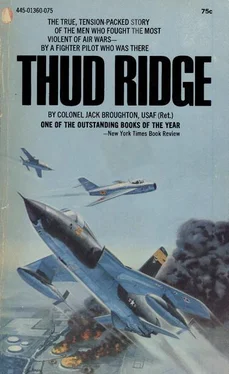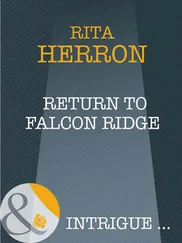To the men who fought there, the string of small mountains that stretches like a long bony ringer to the north and west of Hanoi is known as Thud Ridge. From Hanoi’s view the ridge must have been a geographical indicator that pointed out the direction from which the attacking fighter-bombers would approach the heartland of North Vietnam. For me, as an attacking fighter pilot, Thud Ridge was one of the few easily identifiable landmarks in the hostile North, marking the route to the modern fighter pilot’s private corner of hell—the fierce defenses and the targets of downtown Hanoi.
Thud Ridge sometimes poked its scrubby peaks through the mist and clouds that hung almost incessantly over the area to tell me the weather would never let me get to my target that day. Sometimes Thud Ridge provided shelter from some of the piercing radar eyes of the enemy as I streaked past its sides, leading my companions as low and as fast as I dared to go. To those of us engaged in this most demanding facet of this most peculiar of all wars, Thud Ridge, once we saw it, always served as a reminder that we were among the privileged few to take part in the grimmest contest yet conceived between sophisticated air and ground machinery and people. This singular piece of real estate is the locale of the statistics that have appeared in many a newspaper, and its slopes and peaks now hold the carcasses of the majority of our aircraft classified as “missing in action.” The F-105, affectionately known to her pilots as the “Thud,” carried the bulk of the load against Hanoi from the very start, and these machines and their pilots daily rechristened Thud Ridge.
Someone must tell the story of Thud Ridge and as there are so few of us who have had the opportunity to tell it from the firsthand vantage point of the seat of a Thud over Hanoi, I feel something resembling a duty to set the story down as I see it. It is more than a duty. It is a desire to give permanence to some of the briefing room jazz that flows so wonderfully from pilot to pilot, never to be registered again except over a cool one in the stag bar or through the medium of a less vivid conversation when two comrades in arms meet again after months or years. It is never quite the same the second or third time around. Those of us who were in this thing all went different ways within a short time after our most personal involvement in fighting and surviving. The rapid changes in surroundings and people either dim or brighten the remembrance of the events. And, oh so often, there is just no time to spend in re-creating the feelings when you meet that old wingman again years later. He is rushing past your life, you are rushing past his, and the chance meeting is never satisfactory. It is sure good to see old so-and-so but—got to run—see you again soon—if you are ever in town, give me a call and the wife and I will have you out to dinner; it just isn’t the same.
I have lived this story day and night for what now seems like most of my conscious life. I entered West Point shortly after I turned seventeen, and after an accelerated course that crammed the normal curriculum plus flying training into an unbelievably compact three years, I pinned my wings and bars on my runic and found myself in the middle of the fascinating world of fighting aircraft and fighter people. I have flown every operational fighter plane the Air Corps, and later the Air Force, has owned, from the P-47 to the F-106—with one exception: I never got to fly the F-94, and by the time I recognized that fact, it was a museum piece. (I understand I did not miss too much.) I have about as many fighter hours as anyone, and as I was fortunate enough to break into the jet set early in 1949, my jet fighter time and experience puts me right on top of that heap too. It all adds up to 216 fighter combat missions, but the sense of accomplishment is tempered by the humility you learn from leading your people and equipment into the caldron of aerial combat.
I have also had a part in helping develop the skills and techniques that have made the jet fighter a formidable weapons system. We started the process in Nevada with the Lockheed F-80 “Shooting Star,” when we reopened the desert gunnery school in 1948. I learned a great deal about precision and about extracting the maximum from man and machine as I led the Air Force acrobatic team, the Thunderbirds, from 1954 through 1957. Every time I was due to move on from that job I managed to wangle a new and faster aircraft from the inventory and accept new challenges that culminated in 1956 with the world’s first supersonic precision acrobatic unit. I reveled in the challenges of making the electronically complex F-106 and her pilots perform with distinction through three windswept, subzero winters in Minot, North Dakota, and I wept when I lost superior people because I had not yet fought hard enough to rid the Air Force of the F-106’s bugaboos, among them the killer ejection seat. (My Air Force career almost terminated during a few emotional shouting matches about this ejection seat hi 1964, but we did clean up the F-106 and for the moment reliability and pilot survival triumphed over sterile and unduly complicated engineering and manufacturing techniques.) I even found minuscule areas of satisfaction in the professional education programs that have led me to a master’s degree in the various military and civilian halls of knowledge, but when I completed the National War College in 1965, I knew that the thing I wanted most was to get back with my fighter guys in the real big league of the air war over North Vietnam.
Surprisingly, this was not the easiest thing to accomplish. There always seems to be someone around who wants to manage your career for you, and while I had been relatively successful in the past in dodging the snares of the personnel specialists intent on saddling me with innocuous jobs, I found it much harder to do as a colonel. There are many, many positions, especially in the Washington area, that are filled by virtue of the colonel rank and with little attention to experience. If you engage in a few casual conversations around Washington, you will find that the productive output from these positions is quite often inversely proportional to the amount of assembled rank and the length of the job title. The Air Force has established a section known as the Colonels’ Assignments Branch and their unrewarding task is to select round colonels to fit all the square boxes on all the organizational charts hung throughout the world. The high-level service schools, such as the National War College, are most lucrative hunting grounds for these personnel specialists, and while many prospective selectees succumb to the headquarters pressure, there are some who fight it. There is, however, no guarantee that the fighter will avoid the assignment that he considers less than an honor, and the career implications demand that the fighter use deftness in the attack lest he offend the one he may wind up being assigned to.
The rationale behind the decision to fight or not is quite simple. Once you have a few years under your belt as a colonel you have to make a basic decision. If your prime goal in life is to become a general officer, your best odds, by far, come from going the big staff route. If you fight to stay with operational command in the action areas of the world you will find yourself less liable for promotion, and recent selections give credence to the thought that the farther you are removed from the battle, the better off you are, at least hi terms of your career. Even in an organization designed around airplanes and people, the support expert and the politician regularly outdistance the combat leader in striding toward the highest-level positions. In my case, while I was still at the National War College, I was interviewed for two positions that were clearly oriented toward the easy, nonopera-tional route to promotion. Early in the school year I managed to wriggle out of an assignment to an administrative position in charge of the General Officers’ Assignment Section. (The incumbent was promoted to brigadier general a few months later.) Two months after that it looked like I was hooked for sure on the second interview, and I received a set of printed orders that told me I was designated as Chief of Plans, Office of Legislative Liaison, Headquarters, United States Air Force. It just did not seem to me that the assignment was the best place for a forty-year-old colonel with a wealth of jet fighter experience and’a burning desire to go and fight another war. My maneuver in personnel banditry took some discreet handling and still almost blew up in my face. But although I came close enough to the new and unwanted assignment to attend a welcoming cocktail party, I managed to pull off a last-minute switch and the day I graduated from the National War College I headed for Southeast Asia.
Читать дальше












